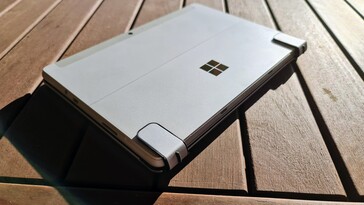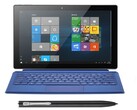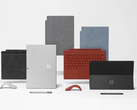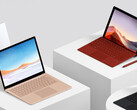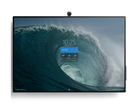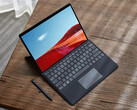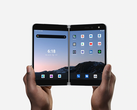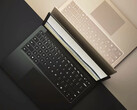Intro:
The original Surface Go was launched in August, 2018. It filled an important niche in Microsoft’s Surface lineup by making its 2-in-1 range more accessible to a wider audience and students in particular. It also held appeal for business professionals on the go who wanted something more compact and easy to use when commuting, although in this use case its appeal was limited by its relatively pokey Pentium Gold 4415Y which was the only choice of CPU on offer. Its 10-inch PixelSense display, while decent enough to look at, was also a little cramped.
Microsoft refreshed the Surface Go with the Surface Go 2 hitting the market in May. Microsoft retained the already pleasing form factor but made things more interesting by upgrading the screen to 10.5-inches while retaining the preferred 3:2 aspect ratio. The company also added an Intel Core m3-8100Y to the lineup for the first time, boosting performance by up to 64%. The LTE model, our review unit, also now comes with an e-SIM built in along with a regular SIM slot while the Wi-Fi gets a boost. In all other aspects, the Surface Go 2 remains the same, including the retention of the meager Pentium Gold 4425Y across the entry-level models, which Microsoft obviously feels is sufficient for its primarily younger audience.
Design, Build Quality and Connectivity:
The Surface Go 2 uses the same highly regarded industrial design language of its larger Surface Pro stablemate. Like that device, and its predecessor, the Surface Go 2 is made from a high-quality magnesium alloy that helps keep its overall heft down to just 544 grams (Wi-Fi) or 553 grams (LTE) in the case of our test unit. Unlike Apple’s potentially bend-prone iPad Pro models, for example, you don’t feel like you need to put the Surface Go 2 in a case to protect it - it manages to be attractive to look at yet is equally robust.
Although the Surface Go 2 features a USB-C connector, Microsoft continues to prefer its Surface Connect port for charging but it does leave the USB-C port for connectivity even if it is a little awkward to use. More welcome, however, is the MicroSDXC port hidden under the kick-stand. Also welcome is the upgraded Wi-Fi that now supports the new Wi-Fi 6 standard. Bluetooth 5.0 is standard across the board as is NFC connectivity. The LTE model also gets an eSIM upgrade meaning that you don’t need to go visit a carrier or order a SIM card online - you can get connected directly out of the box. It also retains a 3.5 mm headphone jack - hallelujah!
Audio-visual Experience:
If there was one aspect of the original Surface Go that was disappointing, it was its 10-inch 3:2 1800x1200 LCD display. While it might have helped Microsoft hit the price point it wanted, it left the Go with bezels that were thick, and therefore, dated in appearance. The display quality was solid, as Microsoft used its PixelSense display technology to create sharp text while videos and photos were colorful and vivid. However, the smaller display also made working on the Surface Go somewhat cramped, leaving its appeal limited as a cross-over device for customers otherwise also looking at the larger Surface Pro.
That has all changed with the Surface Go 2. Its new 10.5-inch 3:2 1920x1280 display is much better from both the perspective of aesthetics and usability. For many people, while working on the go, this new display will offer sufficient space for working in Office apps, surfing the web and viewing content. Colors pop a little more on the new panel as well, although the only downside we noted on our unit was a dreaded backlight bleed that was obvious on the black boot-up screen and when viewing videos at night. Not cool, but replaceable under warranty while Microsoft also offers a 30-day no-questions asked return policy.
An area where the original Surface Go shined and which continues to be the case on the Surface Go 2 is in the audio department. As with the original Surface Go, the Surface Go 2 incorporates 2-W stereo speakers with Dolby Audio tuning. These are front-facing speakers, which is uncommon on tablets with most of the competition employing speakers that fire out of the side. Microsoft’s approach is more satisfying and delivers a properly immersive experience when viewing movies and TV shows. If that is something you are likely to do a lot, then you will appreciate the Surface Go 2 just for this quality.
Performance:
The Intel Core m3-8100Y powering our review unit is a marked step up in performance from the Intel Pentium Gold 4425Y. In fact, Microsoft says that it is 64% faster and this is noticeable on the Surface Go 2 LTE. Undoubtedly, Microsoft has added this chip to the Surface Go 2 lineup to broaden its appeal to business users who don’t really want to go down the road of the Windows 10 on ARM-based Surface Pro X. It isn’t a particularly fast chip, but it is fast enough to make the Surface Go 2 LTE a viable option for people who do want to get some serious Office-style productivity done. RAM is still capped at 8 GB, but this combination is certainly good enough when paired with a snappy SSD as is the case here. We didn’t experience any noticeable interface lag or issues loading multiple webpages and found the overall usability to be right on expectations at the price point.
Battery Life:
Microsoft claims the Surface Go will deliver up to 10 hours of battery life. In our experience, this is more like 6 to 7 hours of mixed use including doing Office-style productivity, surfing the web and viewing content - even with brightness settings reduced. This isn’t great, but it isn’t terrible either. For most people, it will deliver enough battery life to get things done during a typical school or workday, but you will definitely want to keep your charger handy. Microsoft continues to favor its Surface Connect port for charging, but this does leave the USB-C port free for connectivity when filling up on juice. Should you forget your Surface Connect charger, your mobile phone charger over USB-C will keep you powered.
Brydge 10.5 Go+ Keyboard:
Microsoft offers its Surface Go Type Cover separately as a keyboard accessory. We like Microsoft’s Type Covers as they are versatile, functional, and make a worthy companion for the tablet form factor of the Surface Go 2. Although the Surface Go has been on the market for a couple of years, Brydge has only now released a keyboard accessory just in time to take advantage of the launch of the Surface Go 2. This has always been a tantalizing prospect, particularly as this combination has always held the promise of finally delivering netbook nirvana. The timing of the Brydge 10.5 Go+ launch was fortuitous as it gave us the opportunity to pair it with our Surface Go 2 review unit.
Brydge has been making its keyboard dock, shall we call them, for a number of years. Its products were deemed of sufficiently high standard that Google partnered with Brydge for an official keyboard accessory for its Pixel Slate. The same care and attention to detail is evident in its new 10.5 Go+ for the Surface Go and Surface Go 2. The manufacturer has aimed to make a keyboard accessory that Microsoft might have made had it been inclined to develop a product like this for its own product. To this end, its shape and colors have been designed to match as closely as possible with the Surface Go 2 and it has done a good job overall.
We have to say we are big fans of this particular pairing. The Brydge 10.5 Go+ gives the Surface Go 2 the “lapability” that you don’t get with its official Type Cover accessory really giving you the best of both worlds. You can remove it quite easily to use it in the hand as a tablet (although that has never been a reason to buy a Surface 2-in-1 - the portability the form factor offers is of more value), or just keep it “docked” in the two grips that hold it in place either side of the bottom of the display. Connection between the two devices is over Bluetooth, so you do need to wake the keyboard before getting on with whatever you want to get on with.
However, the downsides of the Brydge 10.5 Go+ are far outweighed by its upsides. It succeeds in turning the Surface Go 2 into the ultimate netbook experience. Unlike netbooks of old, however, the Surface Go 2 has solid performance that matches its overall compactness and mobility in this combination. It’s a little heavier than the Type Cover combo, but in return you get a very satisfying typing and trackpad experience that feels like it was a union that had always been intended. For example, something as simple as the inclusion of the brightness control keys makes adjusting the screen brightness far more natural and less cumbersome that relying on the Go's onscreen controls. Brydge really has done a great job of approaching the design of its Brydge 10.5 Go+ as though through the eyes of Microsoft in designing this accessory.
Conclusion:
The Microsoft Surface Go 2 may be a relatively modest refresh overall. However, it has sufficiently addressed the key concerns raised about the original Surface Go by delivering a larger display in the same desirable form factor and by offering a more worthy chip in the form of the Intel Core m3-8100Y as an option. For fans of compact form factor devices, the Surface Go 2 could be just what the doctor ordered, particularly if being able to get Office-style productivity done in a hassle-free way is a priority. It also works great for “lean back” use when it comes to light entertainment - it most certainly is not for gaming - that you will have to leave to your smartphone. That said, if you have a Samsung smartphone, DeX for Windows 10 could allay those concerns. Together, the Brydge 10.5 Go+ and the Surface Go 2 is a winning combination and one that we recommend to people looking for a multipurpose, portable and compact work and entertainment solution.
Stay tuned for our full and in-depth review which is coming soon.


 Deutsch
Deutsch English
English Español
Español Français
Français Italiano
Italiano Nederlands
Nederlands Polski
Polski Português
Português Русский
Русский Türkçe
Türkçe Svenska
Svenska Chinese
Chinese Magyar
Magyar





